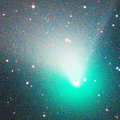
|
Now it is very bright as 7.6 mag (Dec. 28, Carlos Labordena). It will approach to Earth down to 0.29 a.u. in February, and it is expected to brighten up to 5 mag. In the Northern Hemisphere, it stays observable in excellent condition for a long time. In the Southern Hemisphere, it is not observable until early February.
Date(TT) R.A. (2000) Decl. Delta r Elong. m1 Best Time(A, h)
Dec. 31 15 53.23 30 40.0 1.066 1.132 66 7.7 5:37 (259, 44)
Jan. 7 15 51.43 34 13.9 0.871 1.116 73 7.2 5:38 (257, 51)
|

|
Now it is very bright as 7.9 mag (Dec. 26, Martin Masek). It is observable at 8 mag for a long time from 2022 to 2023. In the Southern Hemisphere, it stays observable for a long time, although it becomes low temporarily from November to December. In the Northern Hemisphere, it is not observable until 2023 summer.
Date(TT) R.A. (2000) Decl. Delta r Elong. m1 Best Time(A, h)
Dec. 31 18 43.72 -64 41.9 2.416 1.803 41 7.8 18:28 ( 30,-33)
Jan. 7 19 21.61 -67 9.2 2.373 1.812 44 7.8 18:33 ( 28,-33)
|
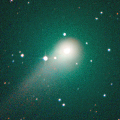
|
Now it is 9.8 mag (Dec. 27, Carlos Labordena). It stays bright as 10 mag for a long time until 2023 autumn. In the Northern Hemisphere, it stays observable in good condition until 2023 autumn. In the Southern Hemipshere, it stays unobservable until 2023 summer.
Date(TT) R.A. (2000) Decl. Delta r Elong. m1 Best Time(A, h)
Dec. 31 2 30.59 81 43.9 2.071 2.663 116 9.8 19:49 (180, 44)
Jan. 7 1 47.13 76 7.9 2.062 2.621 114 9.8 18:41 (180, 49)
|
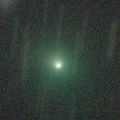
|
Brightening very rapidly. Now it is very bright as 10.4 mag (Dec. 28, Osamu Miyazaki). It stays 10-11 mag until March. In the Northern Hemisphere, it will be observable in good condition after this. In the Southern Hemisphere, it is not observable until 2023 June.
Date(TT) R.A. (2000) Decl. Delta r Elong. m1 Best Time(A, h)
Dec. 31 15 30.56 47 22.8 1.705 1.850 82 11.2 5:37 (236, 52)
Jan. 7 16 13.10 51 37.8 1.646 1.820 83 11.0 5:38 (229, 49)
|

|
It brightened up to 8.3 mag in last winter (Jan. 6, 2022, Toshiyuki Takahashi). Now it is fading. But it is bright as 11.2 mag still now (Dec. 28, Osamu Miyazaki).
Date(TT) R.A. (2000) Decl. Delta r Elong. m1 Best Time(A, h)
Dec. 31 9 55.99 -30 30.7 4.347 4.752 108 11.3 3:20 ( 0, 24)
Jan. 7 9 52.98 -31 37.8 4.317 4.791 113 11.4 2:49 ( 0, 23)
|
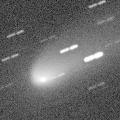
|
Now it is 11.7 mag (Dec. 26, Chris Wyatt). Appearing in the morning sky also in the Southern Hemisphere. It stays 11-12 mag until spring.
Date(TT) R.A. (2000) Decl. Delta r Elong. m1 Best Time(A, h)
Dec. 31 14 29.28 -12 25.9 1.853 1.606 59 11.5 5:37 (320, 33)
Jan. 7 14 48.29 -13 43.8 1.816 1.614 62 11.5 5:38 (323, 33)
|
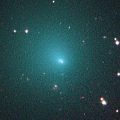
|
Now it is bright as 11.0 mag (Dec. 7, Jose Guilherme de S. Aguiar). It will be fading after this. In the Southern Hemisphere, it becomes unobservable temporarily from December to January. In the Northern Hemisphere, it is not observable until spring when it fades down to 15 mag.
Date(TT) R.A. (2000) Decl. Delta r Elong. m1 Best Time(A, h)
Dec. 31 19 27.37 -38 10.6 2.555 1.650 18 11.6 18:28 ( 55,-17)
Jan. 7 19 26.96 -38 5.0 2.598 1.675 16 11.8 18:33 ( 59,-23)
|

|
Now it is 13.2 mag (Nov. 27, Ken-ichi Kadota). It is expected to brighten up to 11 mag in 2023. In the Southern Hemisphere, it stays observable in good condition for a long time, although it becomes unobservable temporarily from November to January. In the Northern Hemisphere, it is not observable until 2024 autumn.
Date(TT) R.A. (2000) Decl. Delta r Elong. m1 Best Time(A, h)
Dec. 31 18 23.93 -25 5.7 4.301 3.321 3 11.9 5:37 (290,-16)
Jan. 7 18 31.49 -26 13.5 4.262 3.296 9 11.9 5:38 (293,-13)
|

|
It will approach to Sun down to 0.1 a.u. on Jan. 31. In the Northern Hemisphere, it will appear in the morning sky at 9 mag in mid February, then it stays observable while the comet will be fading. In the Southern Hemisphere, it stays observable for a long time, although it is not observable from mid January to mid February.
Date(TT) R.A. (2000) Decl. Delta r Elong. m1 Best Time(A, h)
Dec. 31 19 50.50 -42 40.7 1.746 0.944 24 13.6 18:28 ( 49,-16)
Jan. 7 20 11.77 -40 56.7 1.599 0.788 22 12.5 18:33 ( 51,-16)
|
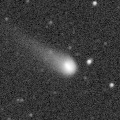
|
Now it is 12.4 mag (Dec. 18, Jose Guilherme de S. Aguiar). It stays 12 mag until summer. In the Northern Hemisphere, it stays observable in good condition for a long time. It is appearing in the morning sky also in the Southern Hemisphere. It stays observable in good condition after this.
Date(TT) R.A. (2000) Decl. Delta r Elong. m1 Best Time(A, h)
Dec. 31 13 51.75 3 47.7 3.844 3.712 74 12.7 5:37 (318, 51)
Jan. 7 13 50.04 3 10.1 3.706 3.699 81 12.6 5:38 (330, 54)
|
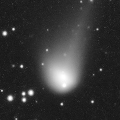
|
Now it is bright as 13.3 mag (Dec. 24, Martin Masek). It stays 13 mag until spring. It stays observable in good condition for a while after this. It will be getting higher rapidly also in the Southern Hemisphere.
Date(TT) R.A. (2000) Decl. Delta r Elong. m1 Best Time(A, h)
Dec. 31 15 5.80 -0 44.9 5.041 4.569 56 12.9 5:37 (302, 36)
Jan. 7 15 11.84 -0 9.1 4.970 4.591 61 12.9 5:38 (307, 40)
|
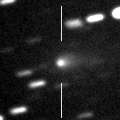
|
Now it is 13.5 mag (Dec. 18, Jose Guilherme de S. Aguiar). It stays bright as 13 mag and observable in excellent condition until February.
Date(TT) R.A. (2000) Decl. Delta r Elong. m1 Best Time(A, h)
Dec. 31 8 44.66 8 37.4 0.954 1.856 146 12.9 2:09 ( 0, 64)
Jan. 7 8 43.13 9 30.9 0.932 1.867 154 12.9 1:40 ( 0, 64)
|
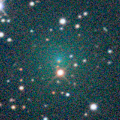
|
Brightening very rapidly. Now it is very bright as 11.6 mag (Dec. 28, Martin Masek). In the Northern Hemisphere, it stays observable in excellent condition. In the Southern Hemisphere, it is not observable until February.
Date(TT) R.A. (2000) Decl. Delta r Elong. m1 Best Time(A, h)
Dec. 31 21 9.47 75 40.4 0.741 1.345 101 13.6 18:28 (164, 41)
Jan. 7 22 57.99 77 34.6 0.675 1.332 105 13.4 18:33 (169, 44)
|
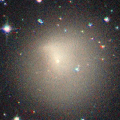
|
It brightened in major outburst in late November. Now it is very bright as 10.9 mag (Dec. 29, Martin Masek).
Date(TT) R.A. (2000) Decl. Delta r Elong. m1 Best Time(A, h)
Dec. 31 6 37.59 29 28.0 5.079 6.057 173 13.4 0:03 ( 0, 84)
Jan. 7 6 33.77 29 26.0 5.090 6.059 169 13.4 23:27 ( 0, 84)
|
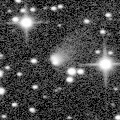
|
Now it is 14.2 mag (Dec. 26, Chris Wyatt). The brightness evolution is slower than originally predicted. It stays 13.5 mag until next summer. In the Northern Hemisphere, it stays observable in good condition until spring. In the Southern Hemisphere, it stays observable in good condition for a long time.
Date(TT) R.A. (2000) Decl. Delta r Elong. m1 Best Time(A, h)
Dec. 31 3 33.95 -2 47.9 1.756 2.485 128 13.5 20:54 ( 0, 52)
Jan. 7 3 26.82 -5 25.3 1.809 2.440 118 13.5 20:20 ( 0, 49)
|
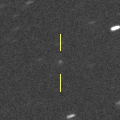
|
It will brighten up to 13 mag in winter. But the condition is bad. It is not observable until February in the Southern Hemisphere, or until May in the Northern Hemisphere.
Date(TT) R.A. (2000) Decl. Delta r Elong. m1 Best Time(A, h)
Dec. 31 17 32.86 -24 52.6 2.532 1.604 15 13.7 5:37 (296, -6)
Jan. 7 17 56.11 -25 26.3 2.509 1.596 17 13.5 5:38 (297, -6)
|
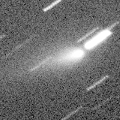
|
Outburst occured in early October, and it brightened up to 9.9 mag (Oct. 14, Thomas Lehmann). It is bright as 13.2 mag still now (Dec. 26, Chris Wyatt). It stays observable only until February in the Southern Hemisphere, or until March in the Northern Hemisphere.
Date(TT) R.A. (2000) Decl. Delta r Elong. m1 Best Time(A, h)
Dec. 31 23 8.82 -14 53.0 2.103 1.888 63 13.7 18:28 ( 34, 33)
Jan. 7 23 23.88 -12 50.1 2.230 1.951 60 14.2 18:33 ( 40, 33)
|
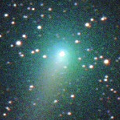
|
It brightened up to 9.3 mag in early summer (June 5, Chris Wyatt). Now it is fading. It has already faded down to 15.5 mag (Dec. 10, iTelescope Observatory, Siding Spring). In the Southen Hemisphere, it stays observable in good condition for a long time. It became observable also in the Northern Hemisphere. But it stays locating low for a while.
Date(TT) R.A. (2000) Decl. Delta r Elong. m1 Best Time(A, h)
Dec. 31 8 37.61 -42 41.3 2.570 3.032 108 14.1 2:02 ( 0, 12)
Jan. 7 8 20.44 -41 26.6 2.562 3.095 114 14.2 1:18 ( 0, 13)
|
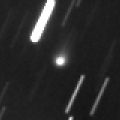
|
Now it is 14.4 mag (Dec. 20, Chris Wyatt). It stays 14 mag in 2023. In the Southern Hemisphere, it stays observable in good condition for a long time. It locates somewhat low in the Northern Hemisphere.
Date(TT) R.A. (2000) Decl. Delta r Elong. m1 Best Time(A, h)
Dec. 31 3 44.29 -22 16.7 2.956 3.524 117 14.3 21:04 ( 0, 33)
Jan. 7 3 30.24 -21 3.3 3.023 3.498 111 14.3 20:23 ( 0, 34)
|
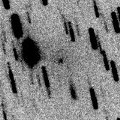
|
Tiny comet, but it will approach to Sun down to 0.8 a.u. in January, and to Earth down to 0.6 a.u. in March. It will brighten up to 14 mag from January to March. In the Southern Hemisphere, it stays observable in good condition for a long time. In the Northern Hemisphere, it is not observable now. It will become observable in early March. It has not been observed since late October.
Date(TT) R.A. (2000) Decl. Delta r Elong. m1 Best Time(A, h)
Dec. 31 21 8.53 -46 35.4 1.481 0.930 38 15.0 18:28 ( 36, -7)
Jan. 7 21 23.88 -49 46.7 1.419 0.882 37 14.7 18:33 ( 36,-12)
|
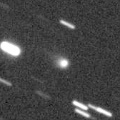
|
Now it is 14.8 mag (Dec. 26, Chris Wyatt). It is expected to brighten up to 8 mag in July. It will be getting lower after this. And it will be unobservable in February. In the Southern Hemisphere, it will be observable in excellent condition at the high light. In the Northern Hemisphere, it becomes very low at the high lihght.
Date(TT) R.A. (2000) Decl. Delta r Elong. m1 Best Time(A, h)
Dec. 31 0 38.11 -13 45.8 3.049 3.112 84 14.9 18:28 ( 9, 41)
Jan. 7 0 32.72 -13 46.4 3.119 3.042 76 14.8 18:33 ( 21, 39)
|
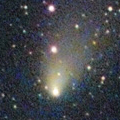
|
It brightened up to 10.4 mag from June to July (July 22, Ken-ichi Kadota). Now it is fading. Appearing in the morning sky in the Souther Hemisphere. However, now it is not detected, fainter than 17.5 mag (Nov. 29, Martin Masek). It will never be observable again in the Northern Hemisphere.
Date(TT) R.A. (2000) Decl. Delta r Elong. m1 Best Time(A, h)
Dec. 31 18 6.32 -64 48.3 3.155 2.513 42 14.9 5:37 (330,-31)
Jan. 7 18 37.49 -65 0.1 3.226 2.593 42 15.1 5:38 (330,-31)
|

|
Now it is 14.8 mag (Dec. 8, ATLAS Chile). It will be unobservable soon. But it will be observable at 15 mag again in 2023.
Date(TT) R.A. (2000) Decl. Delta r Elong. m1 Best Time(A, h)
Dec. 31 20 51.43 -24 40.6 3.971 3.161 30 15.0 18:28 ( 55, 5)
Jan. 7 21 2.46 -23 54.1 4.026 3.170 25 15.0 18:33 ( 59, 2)
|

|
Now it is 15.1 mag (Oct. 26, Thomas Lehmann). The brightness evolution is slower than originally expected. It stays 14-15 mag for a long time. Now it is not observable. It will be observable in early January in the Northern Hemisphere, or in early February in the Southern Hemisphere.
Date(TT) R.A. (2000) Decl. Delta r Elong. m1 Best Time(A, h)
Dec. 31 17 42.98 -12 27.4 4.065 3.138 17 15.0 5:37 (285, -1)
Jan. 7 17 47.56 -11 10.7 4.046 3.162 22 15.0 5:38 (287, 4)
|
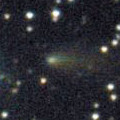
|
Now it is 15.1 mag (Dec. 26, Chris Wyatt). It will be fading after this, and it will be fainter than 18 mag in spring. It is observable in good condition in the Northern Hemisphere. It locates somewhat low in the Southern Hemisphere.
Date(TT) R.A. (2000) Decl. Delta r Elong. m1 Best Time(A, h)
Dec. 31 7 58.27 21 51.9 1.570 2.522 161 15.2 1:23 ( 0, 77)
Jan. 7 7 53.05 22 31.3 1.567 2.541 170 15.3 0:50 ( 0, 77)
|
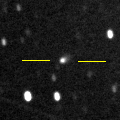
|
Now it is 15.5 mag (Dec. 24, Martin Masek). It is expected to brighten up to 7 mag in early 2024. In the Southern Hemisphere, it stays observable in good condition for a long time. In the Northern Hemisphere, it stays low in 2022.
Date(TT) R.A. (2000) Decl. Delta r Elong. m1 Best Time(A, h)
Dec. 31 5 43.43 -38 33.2 4.563 5.085 116 15.4 23:03 ( 0, 16)
Jan. 7 5 37.75 -38 34.5 4.521 5.020 115 15.3 22:30 ( 0, 16)
|
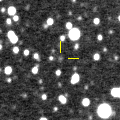
|
Now it is 15.8 mag (Dec. 15, ATLAS South Africa). It will brighten up to 13 mag from 2024 to 2025. It is observable in excllent condition in the Southern Hemisphere. It locates low in the Northern Hemisphere.
Date(TT) R.A. (2000) Decl. Delta r Elong. m1 Best Time(A, h)
Dec. 31 9 12.15 -38 23.3 6.414 6.795 108 15.4 2:36 ( 0, 17)
Jan. 7 9 10.29 -38 49.2 6.323 6.761 112 15.3 2:07 ( 0, 16)
|
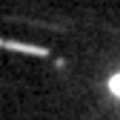
|
Now it is 16.4 mag (Dec. 14, Ken-ichi Kadota). It will brighten rapidly up to 14 mag in spring. In the Southern Hemisphere, appearing in the morning sky. It will be observable in excellent condition in spring. In the Northern Hemisphere, it is observable in good condition in winter, but it becomes somewhat low in spring.
Date(TT) R.A. (2000) Decl. Delta r Elong. m1 Best Time(A, h)
Dec. 31 13 44.89 -5 41.6 2.533 2.428 72 15.6 5:37 (328, 44)
Jan. 7 13 53.45 -7 13.2 2.436 2.417 77 15.5 5:38 (335, 44)
|
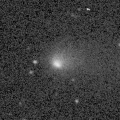
|
Now it is 15.2 mag (Dec. 12, W. Pei). It stays observable in good condition for a long time. But it will be fading after this, and it will be fainter than 18 mag in spring.
Date(TT) R.A. (2000) Decl. Delta r Elong. m1 Best Time(A, h)
Dec. 31 1 39.41 2 46.4 1.718 2.189 104 15.6 19:01 ( 0, 58)
Jan. 7 1 47.00 3 42.5 1.807 2.202 100 15.8 18:41 ( 0, 59)
|
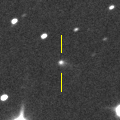
|
Now it is 15.4 mag (Dec. 15, Masayoshi Yoshimi). It stays 16 mag and observable in good condition until spring.
Date(TT) R.A. (2000) Decl. Delta r Elong. m1 Best Time(A, h)
Dec. 31 9 36.67 20 1.4 2.589 3.391 138 15.8 3:01 ( 0, 75)
Jan. 7 9 36.90 20 54.1 2.525 3.384 145 15.8 2:34 ( 0, 76)
|
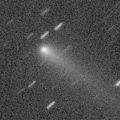
|
It brightened up to 14.1 mag in autumn (Nov. 14, Thomas Lehmann). Now it is fading. It has already faded down to 16.0 mag (Dec. 13, ATLAS-HKO, Haleakala). It stays observable in excellent condition for a while.
Date(TT) R.A. (2000) Decl. Delta r Elong. m1 Best Time(A, h)
Dec. 31 2 1.88 27 50.3 1.860 2.480 118 15.8 19:24 ( 0, 83)
Jan. 7 2 5.72 28 29.5 1.950 2.494 112 15.9 19:00 ( 0, 84)
|

|
Now it is 14.9 mag (Dec. 26, Chris Wyatt). It was expected to brighten up to 13 mag in spring. But actually, it was fainter than originally expected. In the Southern Hemisphere, it stays observable in good condition for a long time. In the Northern Hemisphere, it stays extremely low for a while.
Date(TT) R.A. (2000) Decl. Delta r Elong. m1 Best Time(A, h)
Dec. 31 2 33.62 -41 13.2 3.447 3.653 94 15.9 19:54 ( 0, 14)
Jan. 7 2 26.30 -38 41.0 3.555 3.686 89 16.0 19:19 ( 0, 17)
|
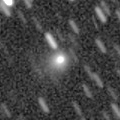
|
It brightened by 6 mag in outburst in early August up to 14.6 mag (Aug. 13, ATLAS-MLO, Mauna Loa). Now it is fading. It has already faded down to 16.8 mag (Dec. 12, A. Diepvens). It will be extremely low after this.
Date(TT) R.A. (2000) Decl. Delta r Elong. m1 Best Time(A, h)
Dec. 31 22 8.37 -8 25.4 2.142 1.724 52 16.0 18:28 ( 53, 30)
Jan. 7 22 27.46 -8 3.1 2.187 1.720 49 16.1 18:33 ( 56, 28)
|
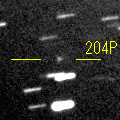
|
Now it is 17.2 mag (Dec. 21, Catalina Sky Survey). It will brighten rapidly, and it will be observable at 16 mag in good condition in winter.
Date(TT) R.A. (2000) Decl. Delta r Elong. m1 Best Time(A, h)
Dec. 31 10 14.25 14 35.3 1.097 1.875 128 16.3 3:38 ( 0, 69)
Jan. 7 10 17.40 15 7.2 1.060 1.889 135 16.2 3:14 ( 0, 70)
|
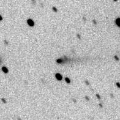
|
Now it is 16.2 mag (Dec. 12, Ken-ichi Kadota). It will be observable at 16-17 mag in excellent condition from autumn to winter.
Date(TT) R.A. (2000) Decl. Delta r Elong. m1 Best Time(A, h)
Dec. 31 4 3.17 -1 33.8 2.729 3.492 134 16.3 21:24 ( 0, 54)
Jan. 7 4 1.49 -1 20.3 2.801 3.496 128 16.3 20:55 ( 0, 54)
|

|
Appearing in the morning sky. It will brighten very rapidly. It is expected to be observable at 11 mag in excellent condition from spring to summer.
Date(TT) R.A. (2000) Decl. Delta r Elong. m1 Best Time(A, h)
Dec. 31 15 31.76 -24 8.7 2.871 2.249 42 16.7 5:37 (314, 14)
Jan. 7 15 47.55 -24 39.9 2.791 2.225 46 16.3 5:38 (317, 16)
|

|
It was observed at 15 mag from 2021 to 2022. Now it is fading. In the Southern Hemisphere, it stays observable in excellent condition for a long time, although it became extremely low temporarily in November. In the Northern Hemiphere, it is not observable after this.
Date(TT) R.A. (2000) Decl. Delta r Elong. m1 Best Time(A, h)
Dec. 31 15 15.36 -59 22.8 6.508 5.934 50 16.3 5:37 (338,-12)
Jan. 7 15 17.45 -60 30.7 6.471 5.962 55 16.3 5:38 (342,-11)
|
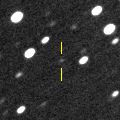
|
Now it is 16.3 mag (Dec. 22, ATLAS South Africa). It is expected to brighten up to 12-13 mag from 2024 to 2025.
Date(TT) R.A. (2000) Decl. Delta r Elong. m1 Best Time(A, h)
Dec. 31 10 23.94 -20 3.0 6.001 6.407 110 16.5 3:48 ( 0, 35)
Jan. 7 10 20.02 -19 54.7 5.854 6.363 117 16.4 3:16 ( 0, 35)
|
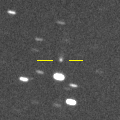
|
Now it is 17.7 mag (July 9, ATLAS Chile). It will brighten up to 16 mag in 2023. In the Southern Hemisphere, it stays observable in good condition for a long time. In the Northern Hemisphere, it will never be observable again.
Date(TT) R.A. (2000) Decl. Delta r Elong. m1 Best Time(A, h)
Dec. 31 14 29.69 -60 2.5 3.707 3.267 56 16.5 5:37 (344, -9)
Jan. 7 14 48.26 -61 57.0 3.658 3.259 58 16.4 5:38 (346,-10)
|
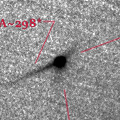
|
Due to the DART spacecraft impact to its satellite Dimorphos on Sept. 26, the cometary activity was detected. It brightened up to 12.9 mag (Sept. 28, John Drummond). It is fading after that. It has already faded down to 15.9 mag (Oct. 29, Katsumi Yoshimoto). It stays observable in good condition for a while.
Date(TT) R.A. (2000) Decl. Delta r Elong. m1 Best Time(A, h)
Dec. 31 7 45.67 29 14.1 0.259 1.235 163 16.6 1:11 ( 0, 84)
Jan. 7 7 34.05 30 10.7 0.291 1.272 170 16.7 0:32 ( 0, 85)
|
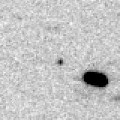
|
Now it is 16.9 mag (Dec. 12, D. Buczynski). It stays observable at 16 mag for a long time from early 2023 to early 2024. In the Northern Hemisphere, it is observable only until 2023 spring.
Date(TT) R.A. (2000) Decl. Delta r Elong. m1 Best Time(A, h)
Dec. 31 10 20.51 0 43.9 3.807 4.406 121 16.8 3:45 ( 0, 56)
Jan. 7 10 14.89 -0 13.6 3.681 4.374 129 16.7 3:12 ( 0, 55)
|
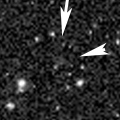
|
Now it is 16.7 mag (Dec. 20, ATLAS South Africa). Very far object. It stays 17 mag for a long time from 2021 to 2026. In the Southern Hemisphere, it stays observable in good condition for a long time. In the Northern Hemisphere, it is not observable at all.
Date(TT) R.A. (2000) Decl. Delta r Elong. m1 Best Time(A, h)
Dec. 31 6 50.62 -76 29.2 10.573 10.453 80 16.9 0:14 ( 0,-22)
Jan. 7 6 34.78 -76 34.6 10.559 10.447 80 16.9 23:24 ( 0,-22)
|
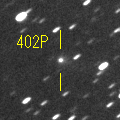
|
It brightened up to 15.3 mag in last winter (Jan. 12, 2022, H. Nohara). Now it is fading. It has already faded down to 17.0 mag (Dec. 1, ATLAS-HKO, Haleakala). It will be observable at 17 mag in good condition in next winter. It locates low in the Southern Hemisphere.
Date(TT) R.A. (2000) Decl. Delta r Elong. m1 Best Time(A, h)
Dec. 31 10 25.99 22 19.3 3.805 4.478 128 17.0 3:50 ( 0, 77)
Jan. 7 10 25.32 23 9.7 3.745 4.496 135 17.0 3:22 ( 0, 78)
|

|
It brightened very rapidly up to 15.5 mag from last autumn to last winter (Nov. 2, 2021, Toshihiko Ikemura, Hirohisa Sato). Now it is fading slowly. It has already faded down to 16.9 mag (Dec. 18, ATLAS Chile).
Date(TT) R.A. (2000) Decl. Delta r Elong. m1 Best Time(A, h)
Dec. 31 6 27.73 9 23.8 3.513 4.474 166 17.2 23:48 ( 0, 64)
Jan. 7 6 23.86 9 22.4 3.545 4.494 162 17.2 23:17 ( 0, 64)
|

|
Now it is 17.9 mag (Dec. 21, Catalina Sky Survey). It brightens rapidly, and it is observable at 16.5 mag in good condition from January to March.
Date(TT) R.A. (2000) Decl. Delta r Elong. m1 Best Time(A, h)
Dec. 31 10 14.56 16 14.3 0.418 1.288 129 17.5 3:38 ( 0, 71)
Jan. 7 10 42.51 18 3.7 0.387 1.268 130 17.2 3:38 ( 0, 73)
|
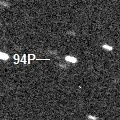
|
Now it is 18.1 mag (Dec. 14, Ken-ichi Kadota). It brightens rapidly, and it is observable at 16.5 mag in good condition in spring. It locates somewhat low in the Southern Hemisphere.
Date(TT) R.A. (2000) Decl. Delta r Elong. m1 Best Time(A, h)
Dec. 31 8 52.29 24 58.3 1.527 2.426 149 17.4 2:17 ( 0, 80)
Jan. 7 8 49.29 25 38.4 1.472 2.408 157 17.2 1:46 ( 0, 81)
|
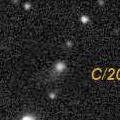
|
Now it is 17.7 mag (Dec. 15, ATLAS-HKO, Haleakala). It stays 17 mag and observable in good condition for a long time until 2023 summer.
Date(TT) R.A. (2000) Decl. Delta r Elong. m1 Best Time(A, h)
Dec. 31 13 36.01 4 33.2 9.010 8.871 78 17.2 5:37 (323, 54)
Jan. 7 13 35.44 4 52.8 8.890 8.876 85 17.2 5:38 (335, 57)
|
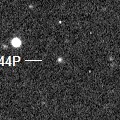
|
Now it is 17.6 mag (Dec. 22, F. Jackson). It is observable at 17 mag in good condition in winter. It locates somewhat low in the Southern Hemisphere.
Date(TT) R.A. (2000) Decl. Delta r Elong. m1 Best Time(A, h)
Dec. 31 6 5.61 26 24.2 2.948 3.924 171 17.2 23:26 ( 0, 81)
Jan. 7 6 1.00 26 22.7 2.971 3.925 163 17.2 22:54 ( 0, 81)
|

|
Now it is 17.5 mag (Dec. 15, P.-J. Dekelver). Fading slowly. In the Northern Hemisphere, it stays observable in good condition for a long time. In the Southern Hemisphere, it is not observable after this.
Date(TT) R.A. (2000) Decl. Delta r Elong. m1 Best Time(A, h)
Dec. 31 17 54.35 63 44.8 9.605 9.610 87 17.3 5:37 (212, 33)
Jan. 7 17 59.33 64 11.4 9.614 9.625 87 17.3 5:38 (212, 36)
|
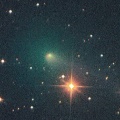
|
It brightened up to 11.1 mag in 2022 spring (May 21, Thomas Lehmann). Now it is fading. It has already faded down to 18.1 mag (Dec. 6, iTelescope Observatory, Siding Spring).
Date(TT) R.A. (2000) Decl. Delta r Elong. m1 Best Time(A, h)
Dec. 31 0 59.30 0 43.0 2.693 2.946 94 17.3 18:28 ( 3, 56)
Jan. 7 1 4.22 1 26.3 2.832 2.986 89 17.5 18:33 ( 15, 56)
|
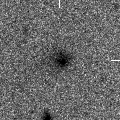
|
Now it is 17.2 mag (Dec. 3, ATLAS Chile). Very large comet. It is expected to brighten up to 14 mag in 2031. In the Southern Hemisphere, it stays observable in good condition for a long time. In the Northern Hemisphere, it is not observable until 2030.
Date(TT) R.A. (2000) Decl. Delta r Elong. m1 Best Time(A, h)
Dec. 31 2 29.41 -60 47.8 18.259 18.153 82 17.4 19:50 ( 0, -6)
Jan. 7 2 28.44 -60 33.9 18.279 18.127 79 17.4 19:22 ( 0, -5)
|
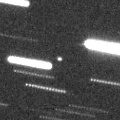
|
Now it is 17.0 mag (Nov. 26, Toshihiko Ikemura, Hirohisa Sato). It will be fading after this.
Date(TT) R.A. (2000) Decl. Delta r Elong. m1 Best Time(A, h)
Dec. 31 7 33.88 19 48.0 0.864 1.836 166 17.5 0:59 ( 0, 75)
Jan. 7 7 21.62 20 2.0 0.912 1.894 176 17.4 0:19 ( 0, 75)
|

|
It brightened up to 14 mag in 2021. Now it is fading. It has already faded down to 17.5 mag (Dec. 20, Martin Masek). It will be fainter than 18 mag in March. It will be unobservable soon in the Southern Hemisphere.
Date(TT) R.A. (2000) Decl. Delta r Elong. m1 Best Time(A, h)
Dec. 31 23 20.47 15 42.9 6.816 6.698 78 17.4 18:28 ( 58, 60)
Jan. 7 23 22.58 15 59.4 6.962 6.737 72 17.5 18:33 ( 67, 54)
|
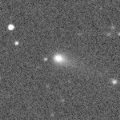
|
Now it is 17.3 mag (Nov. 25, Toshihiko Ikemura, Hirohisa Sato). It continued brightening even after the perihelion passage. It will be fading after this, and it will be fainter than 18 mag in February.
Date(TT) R.A. (2000) Decl. Delta r Elong. m1 Best Time(A, h)
Dec. 31 23 19.58 -2 5.3 4.702 4.478 70 17.5 18:28 ( 40, 45)
Jan. 7 23 24.61 -1 38.0 4.817 4.493 65 17.6 18:33 ( 48, 42)
|
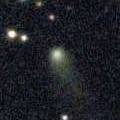
|
Now it is 17.1 mag (Dec. 14, A. Diepvens). Fading slowly. In the Southern Hemisphere, it is not observable after this.
Date(TT) R.A. (2000) Decl. Delta r Elong. m1 Best Time(A, h)
Dec. 31 17 27.03 40 17.2 6.225 5.887 65 17.5 5:37 (239, 30)
Jan. 7 17 34.90 40 59.9 6.230 5.919 67 17.6 5:38 (240, 34)
|

|
Now it is 17.6 mag (Dec. 13, ATLAS-HKO, Haleakala). It stays 17 mag for a long time from 2023 to 2024. It is observable in good condition in the Northern Hemisphere. It locates low in the Southern Hemisphere.
Date(TT) R.A. (2000) Decl. Delta r Elong. m1 Best Time(A, h)
Dec. 31 2 20.14 28 3.0 6.529 7.101 122 17.6 19:42 ( 0, 83)
Jan. 7 2 20.15 27 58.0 6.611 7.086 115 17.6 19:14 ( 0, 83)
|
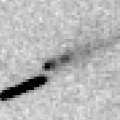
|
It brightened up to 16.1 mag in autumn (Sept. 23, Michael Jager). Then it is fading very rapidly. It has already faded down to 18.0 mag (Nov. 26, H. Nohara). It will be getting higher after this also in the Southern Hemisphere.
Date(TT) R.A. (2000) Decl. Delta r Elong. m1 Best Time(A, h)
Dec. 31 11 15.91 -6 5.6 1.399 1.924 106 17.6 4:40 ( 0, 49)
Jan. 7 11 17.95 -7 35.1 1.365 1.962 112 17.6 4:14 ( 0, 47)
|
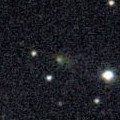
|
Now it is 16.9 mag (Dec. 18, M. Iozzi). It will be fading after this, and it will be fainter than 18 mag in January.
Date(TT) R.A. (2000) Decl. Delta r Elong. m1 Best Time(A, h)
Dec. 31 2 53.99 22 16.5 2.068 2.788 128 17.6 20:15 ( 0, 77)
Jan. 7 2 55.48 22 0.0 2.174 2.817 121 17.8 19:49 ( 0, 77)
|
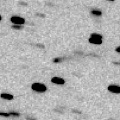
|
Now it is 17.3 mag (Dec. 3, Ken-ichi Kadota). In the Northern Hemisphere, it stays observable at 17 mag in good condition for a long time until winter. In the Southern Hemisphere, it stays extremely low for a long time.
Date(TT) R.A. (2000) Decl. Delta r Elong. m1 Best Time(A, h)
Dec. 31 8 6.42 51 4.8 2.243 3.116 147 17.7 1:31 (180, 74)
Jan. 7 8 0.70 50 59.5 2.260 3.149 149 17.7 0:58 (180, 74)
|

|
Now it is 16.5 mag (Dec. 12, ATLAS Chile). It brightened up to 14 mag from 2020 to 2021. Now it is fading slowly. It will be fainter than 18 mag soon. But it may stay bright for some more time.
Date(TT) R.A. (2000) Decl. Delta r Elong. m1 Best Time(A, h)
Dec. 31 0 13.54 -14 26.2 4.278 4.197 78 17.7 18:28 ( 17, 39)
Jan. 7 0 17.22 -13 34.6 4.396 4.213 72 17.8 18:33 ( 25, 38)
|

|
Now it is 17.6 mag (Dec. 2, ATLAS Chile). It is observable at 17.5 mag in good condition in winter.
Date(TT) R.A. (2000) Decl. Delta r Elong. m1 Best Time(A, h)
Dec. 31 9 2.86 0 8.3 2.705 3.500 138 17.7 2:27 ( 0, 55)
Jan. 7 9 0.81 -0 9.6 2.649 3.498 144 17.7 1:58 ( 0, 55)
|

|
Now it is 19.3 mag (Dec. 23, Mt. Lemmon Survey). It is observable at 17 mag from winter to spring. It locates low in the Southern Hemisphere.
Date(TT) R.A. (2000) Decl. Delta r Elong. m1 Best Time(A, h)
Dec. 31 9 50.45 30 6.0 1.980 2.781 136 17.9 3:15 ( 0, 85)
Jan. 7 9 49.88 31 13.9 1.910 2.762 143 17.7 2:47 ( 0, 86)
|

|
It brightened up to 14.2 mag in 2021 summer (July 18, 2021, Taras Prystavski). Now it is fading. It has already faded down to 17.3 mag (Dec. 22, ATLAS South Africa). In the Southern Hemisphere, it stays observable in good condition for a long time. It locates somewhat low in the Northern Hemisphere.
Date(TT) R.A. (2000) Decl. Delta r Elong. m1 Best Time(A, h)
Dec. 31 1 13.99 -19 5.2 5.894 5.979 90 17.7 18:35 ( 0, 36)
Jan. 7 1 14.38 -18 6.5 6.043 6.024 84 17.8 18:33 ( 7, 37)
|
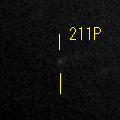
|
Now it is 18.9 mag (Nov. 24, Catalina Sky Survey). It brightens up to 17.5 mag from January to February. It locates somewhat low in the Southern Hemisphere.
Date(TT) R.A. (2000) Decl. Delta r Elong. m1 Best Time(A, h)
Dec. 31 11 46.58 14 59.8 1.908 2.397 107 17.8 5:10 ( 0, 70)
Jan. 7 11 52.44 15 46.9 1.841 2.408 113 17.8 4:48 ( 0, 71)
|

|
It brightened up to 12.3 mag from spring to summer in 2021 (June 15, 2021, Marco Goiato). Now it is fading. It has already faded down to 18.2 mag (Nov. 21, D. Buczynski). It will be fainter than 18 mag in January.
Date(TT) R.A. (2000) Decl. Delta r Elong. m1 Best Time(A, h)
Dec. 31 12 43.06 35 44.4 6.079 6.365 102 17.8 5:37 (262, 84)
Jan. 7 12 41.22 36 52.8 6.027 6.411 108 17.9 5:37 (180, 88)
|
|
![]()
 C/2019 U5 ( PanSTARRS )
C/2019 U5 ( PanSTARRS ) C/2019 T4 ( ATLAS )
C/2019 T4 ( ATLAS ) 118P/Shoemaker-Levy 4
118P/Shoemaker-Levy 4 C/2022 U2 ( ATLAS )
C/2022 U2 ( ATLAS ) 29P/Schwassmann-Wachmann 1
29P/Schwassmann-Wachmann 1 C/2021 Y1 ( ATLAS )
C/2021 Y1 ( ATLAS ) 71P/Clark
71P/Clark 73P/Schwassmann-Wachmann 3
73P/Schwassmann-Wachmann 3 C/2021 E3 ( ZTF )
C/2021 E3 ( ZTF ) C/2021 X1 ( Maury-Attard )
C/2021 X1 ( Maury-Attard ) C/2022 S3 ( PanSTARRS )
C/2022 S3 ( PanSTARRS ) C/2021 T4 ( Lemmon )
C/2021 T4 ( Lemmon ) C/2021 P4 ( ATLAS )
C/2021 P4 ( ATLAS ) 117P/Helin-Roman-Alu 1
117P/Helin-Roman-Alu 1 C/2020 R7 ( ATLAS )
C/2020 R7 ( ATLAS ) 119P/Parker-Hartley
119P/Parker-Hartley C/2021 S3 ( PanSTARRS )
C/2021 S3 ( PanSTARRS ) C/2021 G2 ( ATLAS )
C/2021 G2 ( ATLAS ) 77P/Longmore
77P/Longmore 61P/Shajn-Schaldach
61P/Shajn-Schaldach C/2020 S4 ( PanSTARRS )
C/2020 S4 ( PanSTARRS ) P/2022 L3 ( ATLAS )
P/2022 L3 ( ATLAS ) C/2020 Y2 ( ATLAS )
C/2020 Y2 ( ATLAS ) 285P/LINEAR
285P/LINEAR 204P/LINEAR-NEAT
204P/LINEAR-NEAT 408P/2020 M7 ( Novichonok-Gerke )
408P/2020 M7 ( Novichonok-Gerke ) 237P/LINEAR
237P/LINEAR C/2018 U1 ( Lemmon )
C/2018 U1 ( Lemmon ) C/2022 E2 ( ATLAS )
C/2022 E2 ( ATLAS ) C/2021 C5 ( PanSTARRS )
C/2021 C5 ( PanSTARRS ) (65803) Didymos
(65803) Didymos C/2022 A3 ( Lemmon-ATLAS )
C/2022 A3 ( Lemmon-ATLAS ) C/2019 E3 ( ATLAS )
C/2019 E3 ( ATLAS ) 402P/2020 Q3 ( LINEAR )
402P/2020 Q3 ( LINEAR ) P/2021 N2 ( Fuls )
P/2021 N2 ( Fuls ) 263P/Gibbs
263P/Gibbs 94P/Russell 4
94P/Russell 4 C/2020 F2 ( ATLAS )
C/2020 F2 ( ATLAS ) 244P/Scotti
244P/Scotti C/2019 O3 ( Palomar )
C/2019 O3 ( Palomar ) 22P/Kopff
22P/Kopff C/2014 UN271 ( Bernardinelli-Bernstein )
C/2014 UN271 ( Bernardinelli-Bernstein ) 107P/(4015) Wilson-Harrington
107P/(4015) Wilson-Harrington C/2020 F5 ( MASTER )
C/2020 F5 ( MASTER ) 395P/2020 H1 ( Catalina-NEAT )
395P/2020 H1 ( Catalina-NEAT ) C/2020 H6 ( ATLAS )
C/2020 H6 ( ATLAS ) C/2021 S4 ( Tsuchinshan )
C/2021 S4 ( Tsuchinshan ) 157P/Tritton
157P/Tritton 44P/Reinmuth 2
44P/Reinmuth 2 C/2021 QM45 ( PanSTARRS )
C/2021 QM45 ( PanSTARRS ) 246P/NEAT
246P/NEAT P/2021 V2 ( Fuls )
P/2021 V2 ( Fuls ) 180P/NEAT
180P/NEAT C/2019 F1 ( ATLAS-Africano )
C/2019 F1 ( ATLAS-Africano ) 211P/Hill
211P/Hill C/2020 J1 ( SONEAR )
C/2020 J1 ( SONEAR )![]()



























































